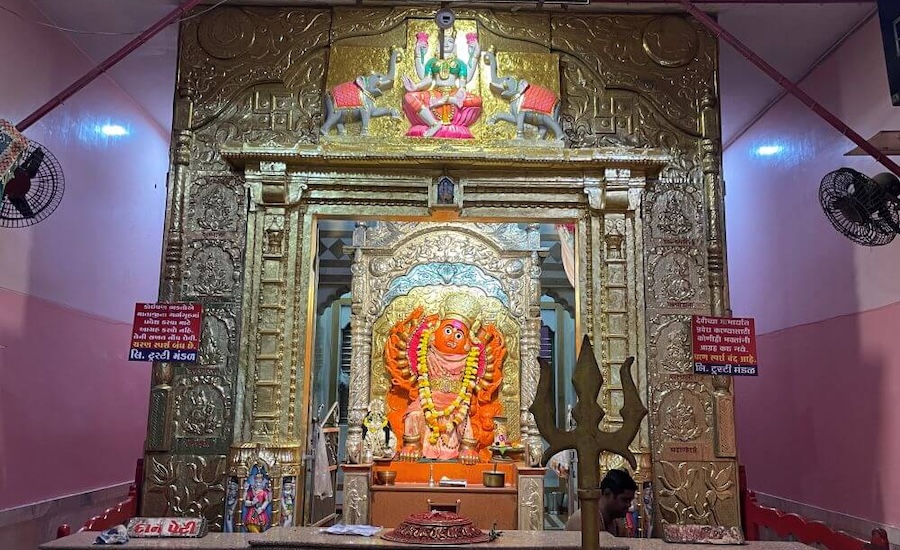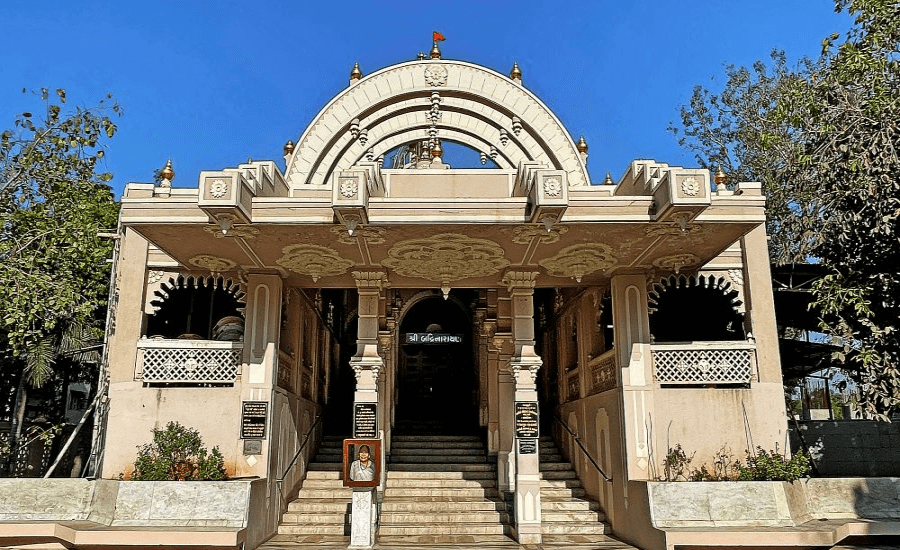
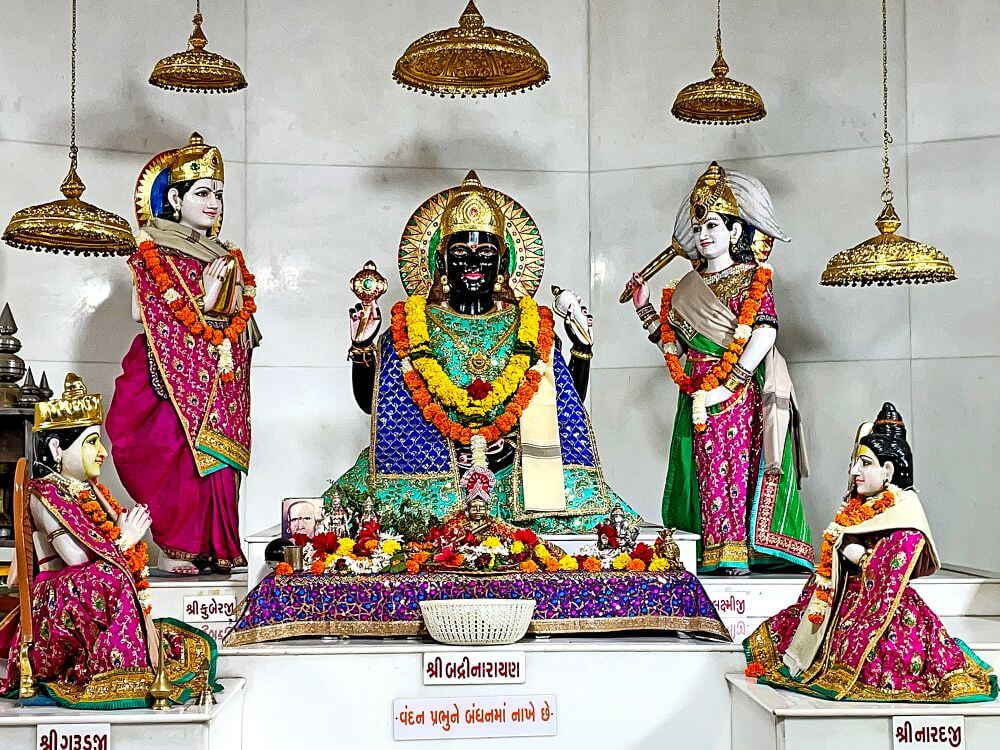 Located on the banks of the Tapi River, Surat is known as the ‘Diamond City’ as well as the ‘City of Temples’. Among its many revered shrines, the Badrinarayan Temple in Adajan is a significant landmark. This temple enshrines not only Lord Badrinath but also deities like Kedarnath, Pashupatinath, Eklingi Mahadev and several others. A perpetual flame brought from the famed Badrinath Temple, one of the sacred Char Dham Yatra destinations, burns here continuously. For countless devotees in Gujarat who are unable to travel to Uttarakhand for Badrinath darshan, this temple serves as a divine alternative.
Located on the banks of the Tapi River, Surat is known as the ‘Diamond City’ as well as the ‘City of Temples’. Among its many revered shrines, the Badrinarayan Temple in Adajan is a significant landmark. This temple enshrines not only Lord Badrinath but also deities like Kedarnath, Pashupatinath, Eklingi Mahadev and several others. A perpetual flame brought from the famed Badrinath Temple, one of the sacred Char Dham Yatra destinations, burns here continuously. For countless devotees in Gujarat who are unable to travel to Uttarakhand for Badrinath darshan, this temple serves as a divine alternative.
Legend has it that Shantaben Kantibhai Patel, a resident of Gujarat and a devoted follower of Shrinathji Niranjan Baba from Nana village in Rajasthan, was instrumental in the temple’s creation. 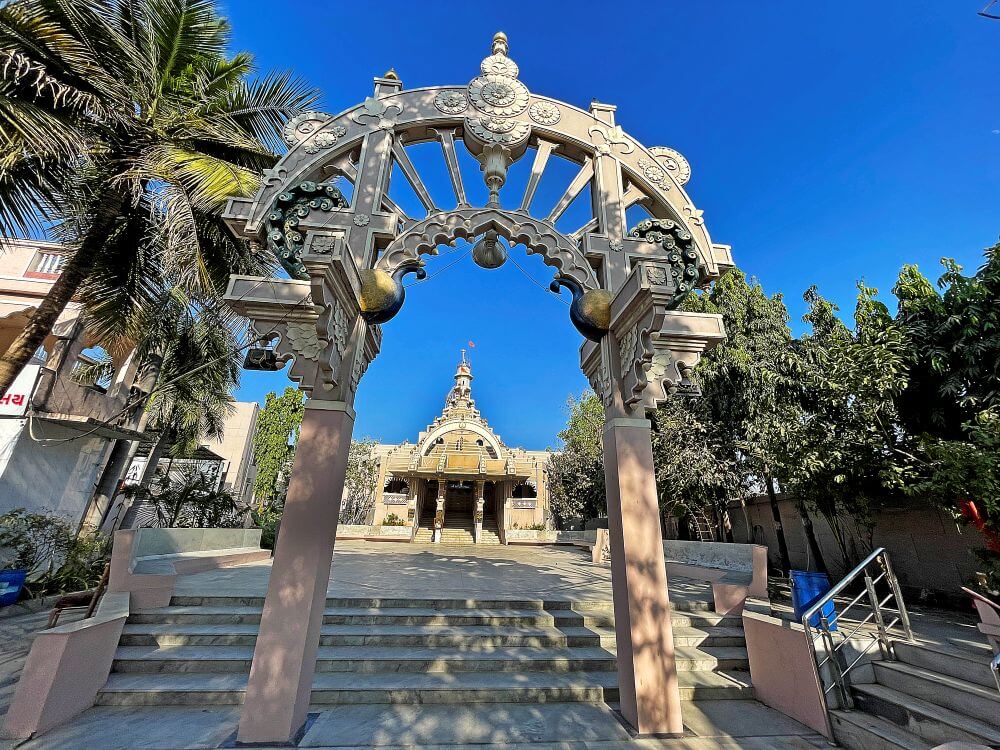 During her visit to Shrinathji in 1964, she asked, “Baba, when will you come to Surat?” Shrinathji gazed toward the sky and replied, “The Mother Tapi has summoned me. I will settle near the bridge.”
During her visit to Shrinathji in 1964, she asked, “Baba, when will you come to Surat?” Shrinathji gazed toward the sky and replied, “The Mother Tapi has summoned me. I will settle near the bridge.”
Though Shantaben could not decipher his words at the time, she felt joyous at the thought of his presence in Surat. Shrinathji attained samadhi in 1968, leaving Shantaben heartbroken but reminded of his prophecy. In 1976, while serving at the Vaikunth Dham Temple in Ahmedabad, Shrinathji appeared in her vision and instructed her to establish a Badrinath Temple in Surat. Initially hesitant due to her commitments at Vaikunth Dham, Shantaben delayed the task. One day, while meditating, Shrinathji Baba appeared to Shantaben in a vision once again. He said, “You will receive a plot of 7,000 square yards for the temple. This temple will house the eternal flame brought from the Badrinath Temple. 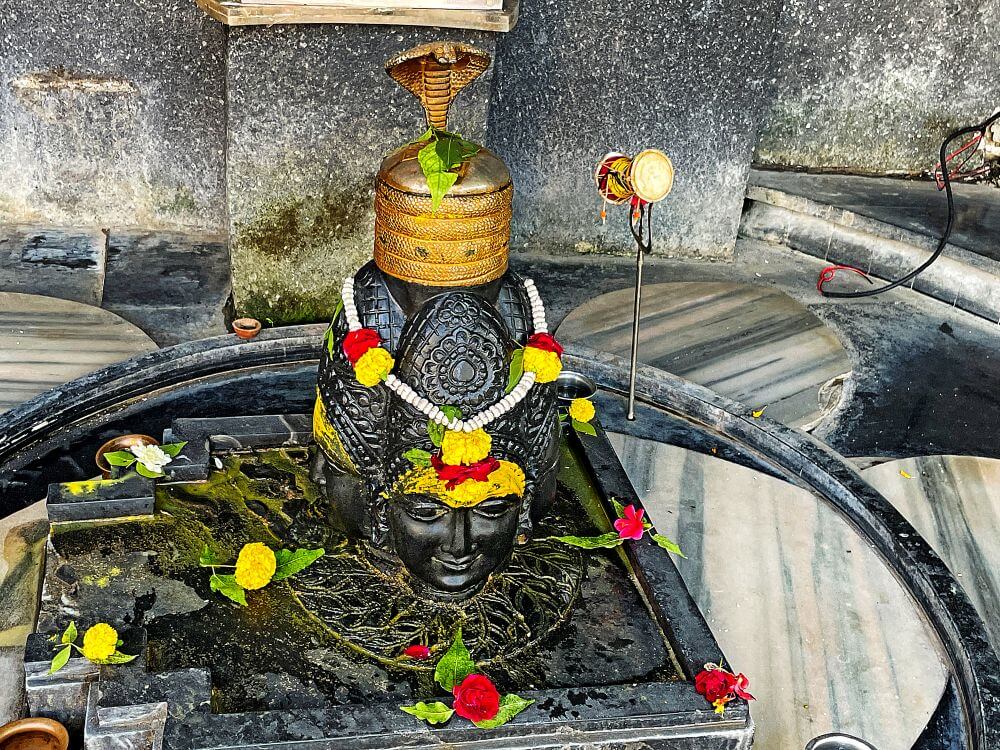 It will take 15 years to complete.” Shantaben, pondering this divine instruction, wondered how she could secure such a large piece of land in Surat, a place where no body knows her.
It will take 15 years to complete.” Shantaben, pondering this divine instruction, wondered how she could secure such a large piece of land in Surat, a place where no body knows her.
Around this time, Sharanmuni (also known as Bholebaba), a devoted disciple of Shrinathji, came to the Vaikunthdham Temple for the consecration of some idols. During his visit, he met Shantaben and conveyed a message from Shrinathji. He said, “I have come here to deliver Shrinathji’s message. Go to Surat before January 26, 1980. Do not worry about the funds required for the temple. When a devotee is given the opportunity to serve God, the necessary resources will surely be provided.”
Following this guidance, Shantaben, accompanied by her husband Arunbhai, relocated to Surat.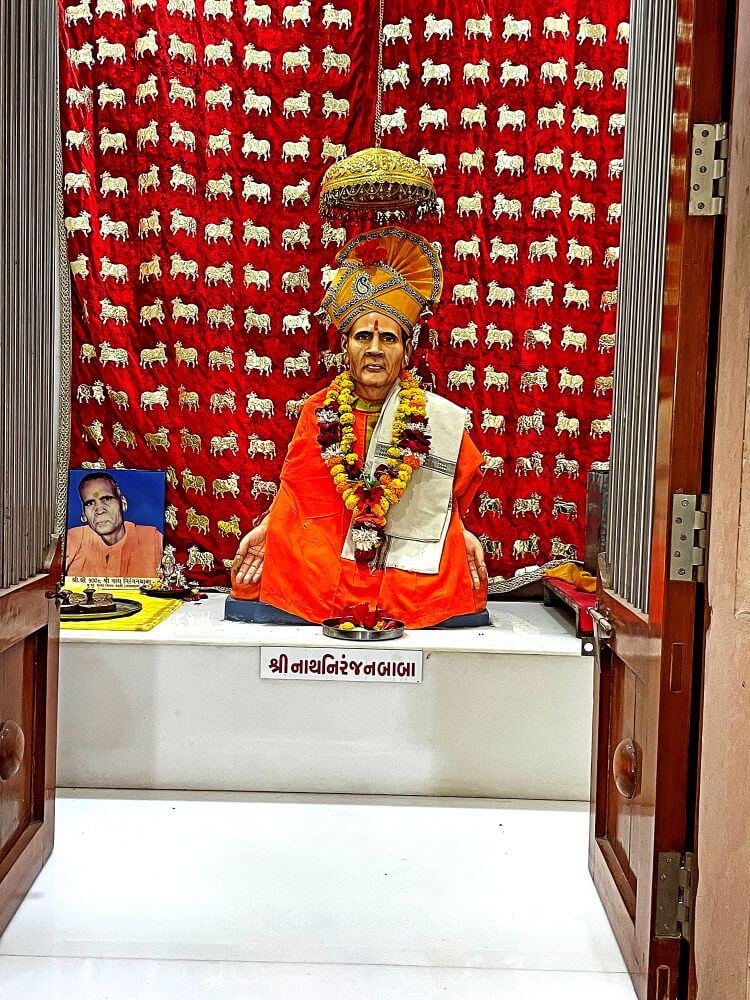 They began exploring various avenues to raise funds for the temple, but their efforts initially met with little success. Finally, in 1982, the Ketwala family generously donated a 7,000-square-yard plot of land to the Shrinath Niranjanbaba Badrikashram Trust. Shortly thereafter, the chief engineer of the family’s business took on the responsibility of constructing the temple.
They began exploring various avenues to raise funds for the temple, but their efforts initially met with little success. Finally, in 1982, the Ketwala family generously donated a 7,000-square-yard plot of land to the Shrinath Niranjanbaba Badrikashram Trust. Shortly thereafter, the chief engineer of the family’s business took on the responsibility of constructing the temple.
The temple’s 45 idols were meticulously crafted by renowned sculptors from Jaipur. Once the construction was completed, the eternal flame from the Badrinath Temple was ceremoniously brought to Surat on May 3, 1998. The Badrinath Temple, one of the 108 Vaishnav Divya Deshams (sacred Vishnu pilgrimage sites) worldwide, is home to an eternal flame lit approximately 1,300 years ago by Adi Shankaracharya. The flame, which continues to burn in the Badrinath Temple, is considered sacred.
Over a three-day celebration, the idols were consecrated by revered Shankaracharyas. During the ceremonies, Shankaracharyas reminded Shantaben of Shrinathji’s prophecy, spoken 32 years earlier, which had now come true.
As visitors approach the temple complex, they are greeted by a magnificent entrance gate leading into a spacious courtyard. 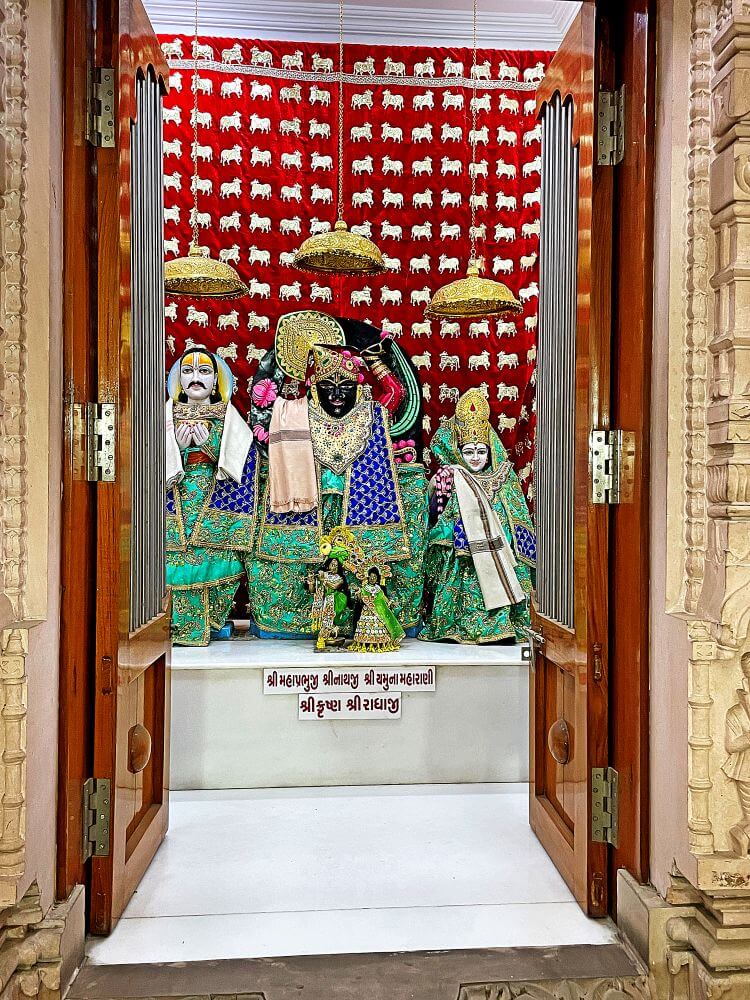 The Shri Shandilya Rishi Vedic Sanskrit College, managed by the temple trust, stands prominently within the premises. On the left is a semi-circular shrine dedicated to Lord Shiva, featuring a stone-carved Nandi statue housed in a glass enclosure. The Shiva lingam within this shrine is a unique mukhlinga, displaying Shiva’s face on all four sides and crowned with a brass serpent. In the niches of the temple walls, idols of Ganesha and Parvati are enshrined.
The Shri Shandilya Rishi Vedic Sanskrit College, managed by the temple trust, stands prominently within the premises. On the left is a semi-circular shrine dedicated to Lord Shiva, featuring a stone-carved Nandi statue housed in a glass enclosure. The Shiva lingam within this shrine is a unique mukhlinga, displaying Shiva’s face on all four sides and crowned with a brass serpent. In the niches of the temple walls, idols of Ganesha and Parvati are enshrined.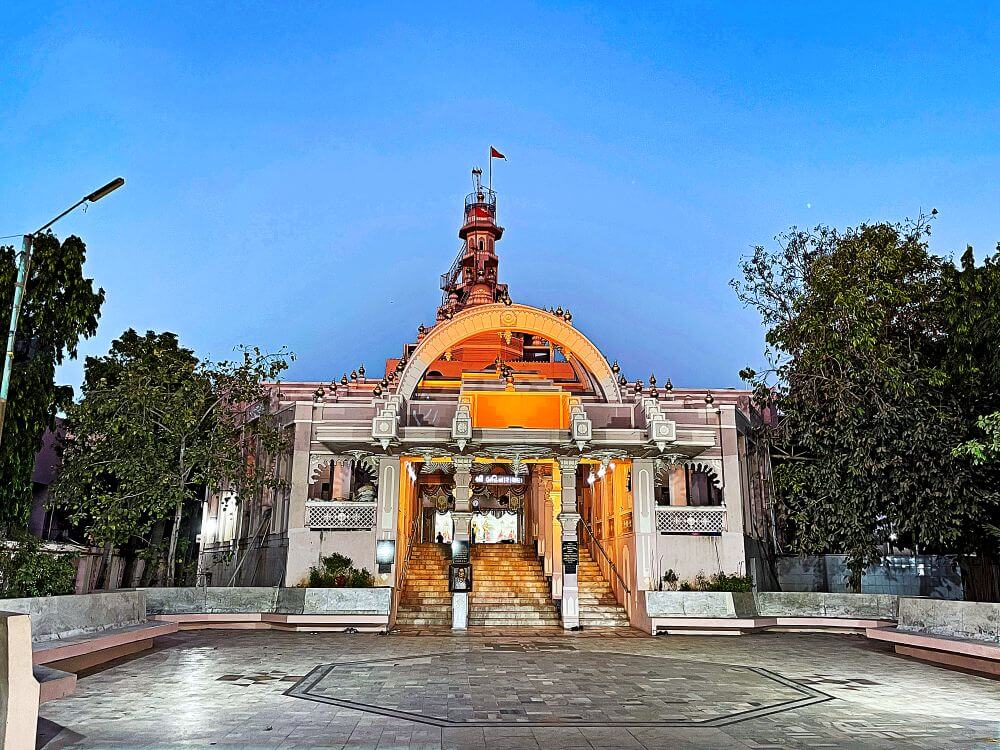
Adjacent to this temple is the entrance to the courtyard of the main Badrinarayan Temple. The entrance is constructed on square pillars and features a beautifully crafted Mayur Toran (a peacock-arched gateway), enhancing the grandeur and aesthetic appeal of the temple premises. Four steps lead to the temple, which is constructed with white marble and stands on an elevated platform. At the base of the staircase, a glass-encased bust of Shantaben Patel commemorates her devotion and efforts.
The assembly hall (sabhamandap) is adorned with intricately carved pillars and ceilings. Within the sanctum, the serene black stone idol of Lord Badrinath presides over an elevated platform. To the left of the deity is Kubera, seated in a respectful pose and Garuda, portrayed kneeling with one leg folded. On the right stands Lakshmi, gently fanning the Lord, with Narada nearby. Adjacent to the idol, the eternal flame brought from the Badrinath Temple burns continuously, symbolizing divine connection. Adjacent to this eternal flame are idols of Uddhava and Ganesha. To the right of Lakshmi’s idol, the divine forms of Narayan and Nar Bhagwan are enshrined, completing the sanctified ensemble of deities in the temple.
Smaller shrines within the temple complex house idols of deities such as Gayatri Devi, Surya Narayan, Dattatreya, Randalmata, Tirupati Balaji, Radha Krishna, Jamnaji Maharaj, Ram-Lakshman-Seeta and more. Other notable shrines include those of Kedarnath, Pashupatinath and Eklingi Mahadev.
The temple conducts daily rituals, including Mangala Aarti, Shringar Aarti, Rajbhog Aarti, Sandhya Aarti and Shayan Aarti. Festivals such as Guru Purnima, Janmashtami, Tulsi Vivah and Sharad Navratri are celebrated with grandeur. During Navratri, the temple organizes yajnas, maha aartis, bhajans and traditional garba dances, attracting thousands of devotees.
Behind the temple lies the Shri Shandilya Rishi Vedic Sanskrit College, where students receive education in Vedic scriptures and Sanskrit. The temple trust also operates a medical clinic and administrative office.
